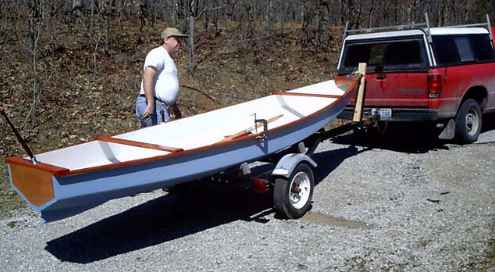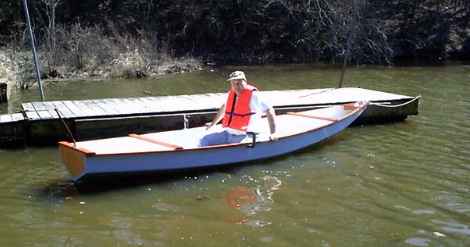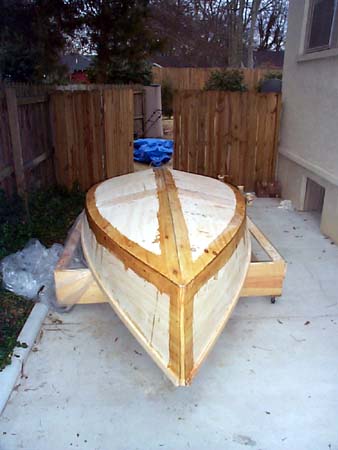
Max Wawrzyniak in his new Oracle.
Contents:
Contact info:
Jim Michalak
118 E Randall,
Lebanon, IL 62254Send $1 for info on 20 boats.
Jim Michalak's Boat Designs
118 E Randall, Lebanon, IL 62254
A page of boat designs and essays.
(15apr03) In this issue we'll talk about setting up a rowing boat. The 1May issue will be about measuring propellor "slip".
THE BOOK IS OUT!
BOATBUILDING FOR BEGINNERS (AND BEYOND)
is out now, written by me and edited by Garth Battista of Breakaway Books. You might find it at your bookstore. If not check it out at the....ON LINE CATALOG OF MY PLANS...
... can now be found at Duckworks Magazine. You order with a shopping cart set up and pay with credit cards or by Paypal. Then Duckworks sends me an email about the order and then I send the plans right from me to you.
THE 14TH MIDWEST HOMEBUILT BOAT MESSABOUT will take place at Rend Lake in Southern Illinois on the weekend of June 7 and 8. Lots of folks come on Friday and leave early Sunday. Take I-57 to exit 77W and then follow the signs to the Gun Creek Recreation Area. Camping at this Corps of Engineers facility is $10/night and that includes the ramp fee. There is no schedule of events except a pot luck dinner in the campground on Saturday evening- we wing it. This year some of us have reserved the campsites on the water of the two middle camping loops so look for us there if we aren't at the boat ramp.

|
Left:
Max Wawrzyniak in his new Oracle.
|
|
|
ROWBOAT SETUP
I've been showing photos of Max Wawzyniak's Oracle prototype for the past few month. The project was done a while back but we were frozen in until about the first week of March. Then it all burst out then and we had a day in the 70'sF and it was time to launch. That particular day the wind was gusting to 30 and no testing was going to get done but it was a good day to take photos and also to set the boat up in the way I like to see it done.
We went to Washington County lake here in Illinois which is about a mile long and with many arms, steep hills around and a shallow launch ramp in a protected area. A very nice rowing lake.

The first thing I must say to those who are finishing a new rowing boat is to not install the rowlocks in the shop! I usually show a rowlock location on the drawing but that is just my best guess at the time I drew the boat. If you have a little patience you can get it just right the first time by following this essay.
Max unloaded his new Oracle and showed me his gear. He had made a low rowing seat, 3-1/2" high, and had some nice 8' oars. The seat looks low but you will usually have a cushion on top and this is a low sided boat. This seat turned out to be just right for Oracle.

Next the boat was placed in the water tied loosely to the dock. Max climbed in and we looked for the seating position that would provided a level boat.
Here he is too far forward and you can see that the bow is down and the stern is up. I might add that it really takes two people to get this just right - one to be the skipper, and another to watch for the correct trim since seeing the trim from inside the boat can be difficult.

Here he is too far aft. The bow is up and the stern is down:

Here he is with his weight located properly for a level boat. At this time he marked the seat location on the bottom of the boat so he could easily repeat the location in the future.

Sitting in the properly trimmed boat Max holds the oars comfortably and notes where they cross the wale.

At those points he places a large C clamp in position to simulate the rowlocks.

Now for a test row using those C clamps as thole pins. If the clamps are large enough you might pass the oar through the opening or you might tie the oars to the clamps. In this case Max was just careful to keep the oars against the clamps.

At this point you can shift things around. Once you find the best place for the oarlocks, note the position and install the lock sockets. In this case Max used common sockets mounted outside the wale. He screwed them into position for now, to replace the screws with small bolts in the future. (Screws have a bad habit of working loose at the worst time.) Sockets mounted outside the wale instead of inside? They function a lot better outside with no chafing on the wale but if you are using the boat as a tender then inside the wale might be better because there will be no metal to gouge the mothership.

Not quite done yet. A good rowing setup will also have cleats inside the hull against which you can brace your feet. It's not a big deal in calm conditions but for rowing hard, and in some conditions all rowing will be hard, the cleats will make a huge difference in the amount of force you can deliver to the oar.
Max didn't install his on his test day but the cleats can be about 3/4" square and 6" long and mounted in a comfortable position. Many rowing boats will have several cleats spaced maybe 3" apart to allow for different sizes of oarsmen. Here is a photo of the cleat in my old Roar2. It was meant to be a temporary fit and was plopped in place with a blob of Bondo. Still temporary after 12 years!

Perhaps just as good as a cleat is the arrangement that Rob Rohde-Szudy made for his Piccup Pram with a rope loop to the seat that captures a bracing bar that rests on the floor of the boat:

NEXT TIME: We'll measure propellor slip.
ORACLE
ORACLE, LIGHT ROWBOAT, 15-1/2' X 45" X 80 POUNDS

Oracle might have been called Roar3. It is a bit longer and lower than Roar2 so it looks sleeker. It is actually closer in shape to my Toto canoe. I'm pretty sure it is a visual improvement over Roar2. Hard to say if it is a practical improvement. Being lower sided it might seem less secure but then again my Roar2 has never taken water over the wale in the ten years I've had it and maybe I've been hauling around excess freeboard. Max Wawrzyniak of St. Louis made the prototype. We rowed our boats side by side on a good day recently. I'd say the Oracle was 1/2 mph faster all around going about 4 mph at cruise and 5+ mph on the gps at full effort. It should float two adults quite nicely.

I'd like to point something about the way I draw the line on many of my boats. I make card models of my designs which help me check the panel expansions and allow me to get a 3D check of the shape. The models are done in the same scale as the blueprint, in this case 1/8 and the model is fairly large. So I knew that Oracle has nice curves all around. But if you look at the end view in the lines drawing you see all straight lines! In a way this is a throwback to the original "instant" boats which had hull panels made from straight saw cuts. It is easy for a designer to make the jump to more flexible shapes, that is hull shapes which can look like about anything you might imagine being made from plywood. Back when I started drawing boats I noticed some of the nicest shapes in 3D had end views made totally of straight line segments. Don't ask me why. Not only does that give a nice shape, the designer's job is simplified. For example, with Oracle I might start by drawing the top view. Then I might sketch in the side view needing nothing more than an idea of what the stem, midsection, and stern will look like. Next I draw the end view which will include those elements connected by straight lines. In normal mechanical drawing it only takes two views to totally define an object. So without even drawing the side view of the boat the shape is defined. It only remains to go back and figure it out and adjust the top view, etc., etc.. Happy is the designer who gets it right the first time through.

Oracle is built with taped seams using four sheets of 1/4" plywood. No jigs, no lofting.

Oracle plans are $20 when ordered direct by mail from me.
Prototype News
Some of you may know that in addition to the one buck catalog which now contains 20 "done" boats, I offer another catalog of 20 unbuilt prototypes. The buck catalog has on its last page a list and brief description of the boats currently in the Catalog of Prototypes. That catalog also contains some articles that I wrote for Messing About In Boats and Boatbuilder magazines. The Catalog of Prototypes costs $3. The both together amount to 50 pages for $4, an offer you may have seen in Woodenboat ads. Payment must be in US funds. The banks here won't accept anything else. (I've got a little stash of foreign currency that I can admire but not spend.) I'm way too small for credit cards.
Here are the prototypes abuilding that I know of:
The Australian Twang builder is done and is testing, searching for the ideal seating position.

The Alabama Skat is getting its seams taped.

A Piragua18 is being completed in Georgia:

AN INDEX OF PAST ISSUES
Hullforms Download (archived copy)
Plyboats Demo Download (archived copy)
Brokeboats (archived copy)
Brian builds Roar2 (archived copy)
Herb builds AF3 (archived copy)
Herb builds RB42 (archived copy)